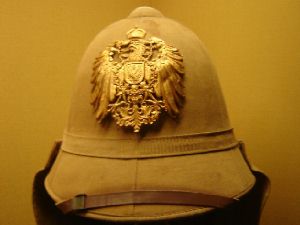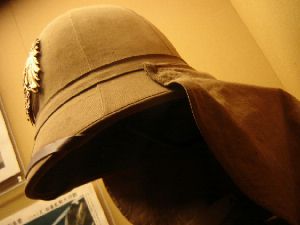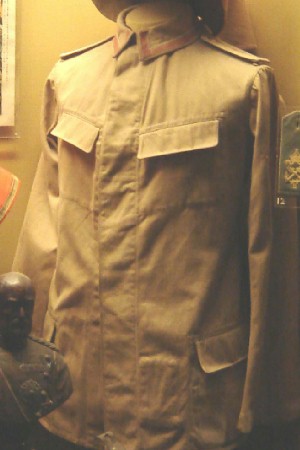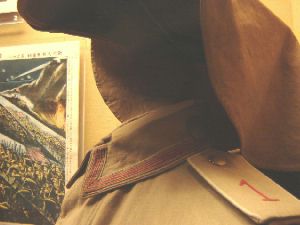|
|
|
German East Asian Troops 1901-09
Summer Uniforms
|
| |
 |
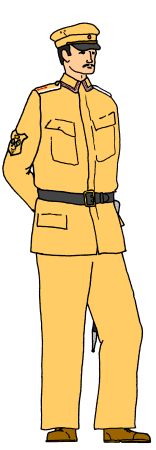 |
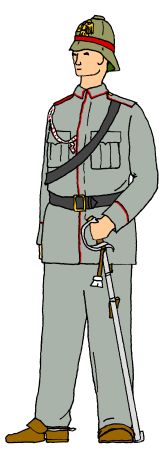 |
|
| |
Figure 1
NCO
5th East Asian Infantry Regt
1900 Summer Uniform |
Figure 2
NCO Standard Bearer
1st East Asian Infantry Regt
1900 Summer Uniform |
Figure 3
Trooper
East Asian Cavalry Squadron
1904 Summer Uniform |
|
Uniforms of the German East Asian
Army 1901-09
Between late 1900 and early 1901 new uniforms in khaki and field grey were
authorised for the East Asian Expeditionary Corps (and its later
successors, the East
Asian Occupation
Brigade and East Asian Detachment). These uniforms are usually referred
to as the 1900 uniforms as parts of them and their design had been
authorised by the Prussian war ministry between
September and December of 1900, although the
Earlier Khaki Uniforms are also
confusingly referred to as 1900 uniforms. The new 1900 uniforms were
finally authorised for the East Asian Expeditionary Corps on 9th
February 1901.
Along with the demise of
the old blue uniforms,
went the different state insignia for Prussia, Bavaria, Saxony,
Württemberg and Baden.
The new uniforms had only the imperial insignia as used by the
Schutztruppe and imperial navy.
The change from the early 1900
uniforms to the later 1900 uniforms was not a smooth one and
period photographs from late 1900 into 1901 often show mixtures of
uniforms being worn, for example an early 1900 straw hat worn with
the late 1900 khaki tunic, or an early 1900 tunic worn with a late
1900 tropical helmet.
1900 Khaki Uniform and 1900
Bortfeldt Helmet from a Sergeant of the 1st East Asian Infantry
Regiment
Photos from the
Imperial War Museum
1900 Khaki Summer Uniform
Tunic
The tunic had a stand and fall collar, concealed buttons
down the front, plain cuffs, two slightly sloped breast pockets and two
straight hip pockets with concealed buttons. There was no piping
on the uniform except on the shoulder straps. The rear was plain
with two yellow metal buttons bearing the imperial crown, to support the belt. Shoulder straps were khaki with
piping and insignia depending on arm of service (see
Arm of Service Details below) and were each held with a small
yellow metal button with the company number (where applicable) on
them.
Insignia
A single chevron of white lace with black and red threads was worn
on the left upper sleeve by all NCOs and officers on the new East
Asian uniforms. NCOs rank was shown in the form of a band
of white lace with red and black
threads around the front and bottom edge of the collar (see right) and a brass
collar buttons (see
NCO Rank Insignia page). NCOs did not display rank lace on the cuffs of the new
khaki uniform. Officer's rank on the new
khaki and field grey uniforms was shown in the usual way, as worn by
the army, Marine Infantry and Schutztruppe, with braided shoulder
straps and pips (see
Officers Rank Insignia page).
Specialist insignia was as worn in
the Imperial army (see
Specialist Insignia page). Other forms of insignia and armbands
worn by the East Asian Occupation Brigade are described on the
Winter Uniform
Page.
Trousers
Trousers were in matching khaki also
without piping and new khaki riding breeches were introduced for
mounted personnel with khaki reinforcement on the inner sides.
Tropical Helmet
In December 1900 the East
Asian straw hat was officially replaced with a tropical helmet ("Tropenhelm") of the
1895 naval pattern made by Ludwig Bortfeldt of Bremen.
It was a
tall cork helmet covered with khaki
cloth. It had a yellow metal (white metal for general staff and
pioneers) imperial eagle with down-swept
wings on the front, a hatband in arm of service colours (see
Arm of Service Details below) and large imperial cockade which was pinned over the hatband
on the right hand side. Period photographs show that the cockade was
also occasionally pinned above the hatband, on the front of the
hatband and in at least one photograph on the left side of the
hatband. The helmet came with a removable khaki neckshade which
fitted with hooks onto the helmet just below the hatband. One curious
period photograph shows the tropical helmet worn with a Pickelhaube
spike in place of the ventilation top of the tropical helmet. In
1902 Bortfeldt designed a newer helmet of similar shape but with a
folding rear peak. This later helmet was issued to the German
army serving in Macedonia and
Palestine during the
First World War.
East
Asian Bortfeldt 1900 Tropical Helmets
See
Tropical Helmets Page |
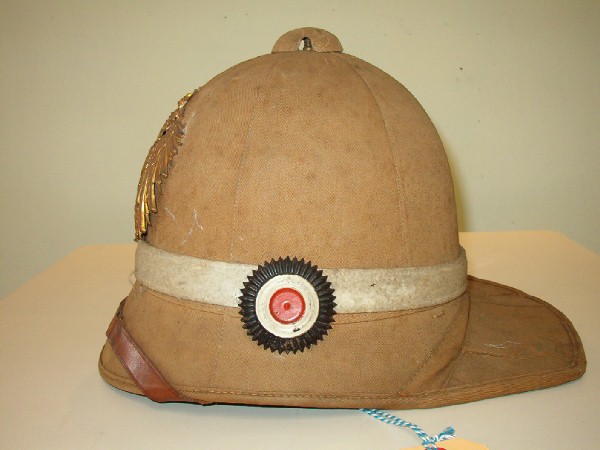 |
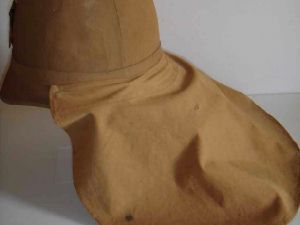 |
 |
With white Infantry Hatband
and Imperial cockade on the wrong side.
Photos by Khukri
originally shown on the
Pickelhaubes Forum |
Without the hatband and cockade
but with
Neckshade
Photo © Doppler Collection |
With Red Cavalry Hatband
Photo ©
Traditionsverband |
| |
|
|
Tropical Shako
Another curious variation of the
tropical helmet was the tropical shako ("Tropen-Tschako").
This was a cork Bortfeldt helmet made in a shape of a Jäger shako
and was worn with a blue hatband by the East Asian Train Company and
very briefly with a green hatband by the East Asian Jäger Company
(who were disbanded in May 1901 shortly after its introduction).
Peaked Cap
The khaki field cap ("Bordmutze") was authorised from 12th August 1900
and replaced the previous straw hat for all troops sent to China after
that date. It was a plain khaki cap with
a khaki hatband, the same as worn by the III. Seebatallion. Until 9th
February 1901 a small imperial cockade was worn on the front of the cap
above a small state cockade. From 9th February 1901 only the imperial
cockade was worn on the front of the cap. The cap had a black leather peak and chinstrap
held by two plain yellow metal buttons, and an internal wire retaining loop to hold
the shape of the crown although the wire band was often removed. A removable neckshade was issued that
attached to the two chinstrap buttons on either side.
A new cap was introduced in early
1901, also confusingly called the 1900 Field Cap. It was a again a
khaki cotton peaked cap but varied in several small ways. The peak
was of grey leather and the chinstrap of brown leather. The
chinstrap buttons were still of yellow metal but now bore an
imperial crown. Most noticeably there were two small ventilation
holes on either side of the upper part of the cap. These each had a
small black metal grill. The officers cap had two ventilation holes
each at the front and back as well as the sides all with yellow
metal grills. Again only the imperial cockade was worn on the front.
|
|
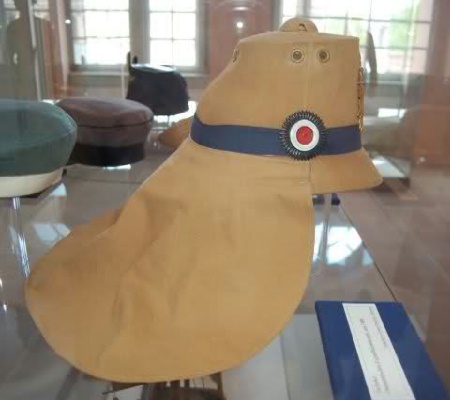
Tropical Shako
with a blue Train hatband
Photo by Kilimandscharo of
the
Kolonial Geschichte Forum
taken at the Rastatt Museum |
| |
|
|
Equipment and Footwear
Equipment was in grey leather and footwear in brown leather as
described on the Winter Uniforms Page.
Mosquito veils were also issued.
1904 Field Grey
Summer Uniform
Uniform
In 1903 is was decided that the old khaki Summer uniform was to
be replaced by a lightweight field grey uniform.
Delays in production meant that the new
Summer uniform was only introduced for the Summer of 1905, except
for newly arrived officers and officials in the Summer of 1904. The
new field grey Summer uniform was
of the same cut as the 1904 Winter uniform.
It had a stand and fall collar, concealed front, plain turn back
cuffs and two pleated breast pockets with pointed flaps.
There were no hip pockets. The rear of the tunic had scalloped flaps
with three yellow metal buttons bearing the imperial crown on either
side. It was piped in red around the
collar, front, cuffs and rear skirts. The shoulder straps were
those worn on the Winter uniform. Rank and specialist insignia was
as before.
| |
|
|
Tropical Helmet
Tropical helmets were now issued field grey.
These new helmets were noticeably smaller in their overall dimensions than the 1900
and 1902 khaki helmets. They bore the
same imperial eagle, imperial cockade on the right hand side and
hatband in arm of service colours (see
Arm of Service Details below).
Surviving examples show that the
shade of field grey for other ranks was more like the grey/green
felt used on East Asian Pickelhaubes, while officers privately purchased examples
may have varied even more with one (shown in "Tropenhelme der kaiserliche Marine, der
Ostasiatischen Truppen und der Schutzruppen"
by Ulrich Schiers) being a pale blue/grey.
Peaked Cap
The khaki cap was replaced with a similar peaked cap all in
field grey. Like the previous officers version it had two small
ventilation holes at the front, sides and rear, all with field grey
metal grills. The cap was worn without the coloured hatband and piping
worn in Winter months but with the imperial cockade on the front and
small ventilation holes.
I have so far found no references to or (or photographs of)
neckshades being worn with the new field grey helmets and caps. |
|
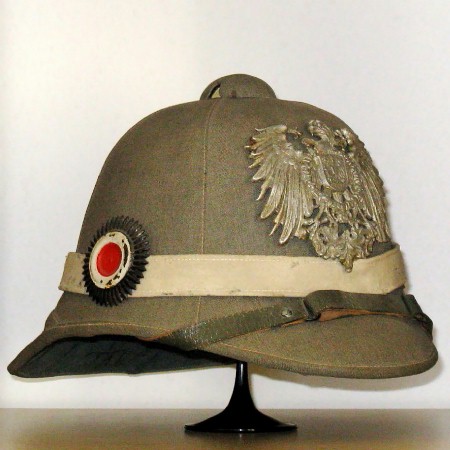
1904 Bortfeldt
Helmet
with a white Infantry hatband, this example has a white
replacement eagle for its original yellow one.
Photos
©
Private Collector |
| |
|
|
| |
|
|
| |
The Illustrations
Figure 1 is based on a
photograph
of an NCO of the 4th (Saxon) Company of the 5th East Asian Infantry Regiment
of the East Asian Expeditionary Corps taken in China in early 1901.
The new uniform was introduced in February 1901 and the 5th Infantry
Regiment was disbanded in May 1901, so this gives us a fairly
accurate dating of the original photograph.
This NCO wears the new 1900 khaki summer uniform
with the NCO lace and button of a Sergeant on his collar. Note the
East Asian rank chevron in imperial coloured lace just visible on
his left arm. His shoulder straps are khaki, piped in white and with
a red regimental number. The tropical helmet has a yellow metal
imperial eagle, a white hatband for the infantry and a large
imperial cockade on the right side. Note this cockade is worn above
the hatband, whereas most were worn on the hatband. His trousers are
worn loose over short brown leather boots. They were usually worn
tucked into brown leather marching boots on active duty. The black
leather belt and buckle is the old style worn by the Expeditionary
Corps. The buckle would then presumably have had a Saxon crown
surrounded by laurel leaves and the motto "Providentiae Memor".
All Prussian, Bavarian and Saxon insignia was officially replaced by
imperial insignia from February 1901. This NCO has no other Saxon
cockades or insignia.
Figure 2 is based on a
photograph
of the Standard Bearer of the 1st East Asian Infantry Regiment taken in
China sometime between 1901-04. He is wearing the new 1900 khaki
summer uniform. Note the NCO lace on the collar,
and the standard bearer's shield insignia on the upper right arm (see
Specialist Insignia Page).
His cap is the new 1900 khaki field cap with grey peak, brown
chinstrap and single imperial cockade. Note the two small
ventilation grills visible on the side. He wears a grey leather belt
and open buckle as authorised in 1901 and a long S98aA bayonet can
just been seen hanging on the left side. Again, his trousers are
worn loose over short brown leather boots. They were usually worn
tucked into brown leather marching boots on active duty
Figure 3 is based on a photograph
of a Trooper of the East Asian Cavalry Squadron probably taken
in the Summer of 1905 (the 1904 Summer Uniform was not introduced to
the bulk of the East Asian Occupation Brigade until the Summer of
1905, and the Cavalry Squadron was disbanded in March 1906). The
original photograph upon which this illustration is based may well have
been taken at a photographic studio in Germany prior to setting sail
for China.
He wears the 1904 field grey Summer uniform, which as described above
was in the same cut as the 1904 Winter uniform. Note the pleated upper
pockets with pointed flaps and lack of hip pockets. His shoulder
straps are piped red. Across his right breast is a marksmanship
lanyard in imperial colours (see
Specialist Insignia page). His helmet is the smaller 1904 field
grey tropical helmet with a yellow metal imperial eagle and a red cavalry hatband.
This trooper again wears his trousers loose over his brown leather
riding boots with spurs. His equipment is the grey leather cavalry
bandolier but without the ammunition pouches attached. His carries
the other ranks 1901 East Asian Cavalry Sword (identical to the
Prussian 1898 Cavalry Sword but with an imperial rather than a
Prussian eagle on the hilt guard). His other ranks sword knot ("Faustriemen")
has a white knot to denote the 1st Squadron (and in the case of the
East Asian Cavalry from 1901-06, the only squadron).
|
|
| |
|
|
|
|
 |
 |
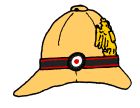 |
 |
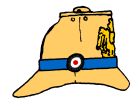 |
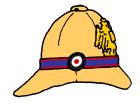 |
 |
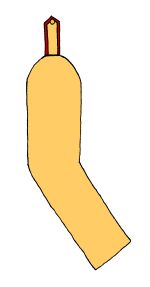 |
 |
 |
 |
 |
Figure A
Infantry |
Figure
B
Cavalry |
Figure
C
Artillery |
Figure
D
Pioneers |
Figure
E
Train |
Figure
F
Medics |
The illustrations above show the arm of service
distinctions worn by the East Asian Occupation Brigade and its successor the
East Asian Detachment on their 1900 khaki uniforms. Summer field caps (the 1900
khaki caps and the 1904 field grey caps) had no coloured hatbands or piping. The
1904 field grey Summer uniforms had the same coloured hatbands on their tropical
helmets as shown here and the same shoulder strap insignia but with field grey
straps.
Figure A shows the insignia
worn by the East Asian Infantry Regiments, in this case the 1st East Asian Infantry Regiment ("1. Ostasiatische
Infanterie Regiment"). The tropical helmet bore a yellow metal imperial
eagle and a white hatband. Shoulder straps were khaki piped in white with the
regimental number in red.
Figure B shows the insignia
worn by the East Asian Cavalry Squadron ("Ostasiatische Eskadron Jäger zu
Pferd").
The tropical helmet bore a yellow metal imperial eagle and a red hatband. Shoulder straps
were khaki piped in red.
Figure C shows the insignia
worn by the East Asian Artillery Detachment ("Ostasiatische Feld Artillerie
Abteilung"). The tropical helmet bore a yellow metal imperial
eagle and a black hatband with red edging. Shoulder straps were khaki piped in
red with a red flaming grenade.
Figure D shows the insignia
worn by the East Asian Pioneer Company ("Ostasiatische
Pionier-Kompanie"). The tropical helmet bore a white metal imperial
eagle and a black hatband with red edging. Shoulder straps were khaki piped in
piped in red with a stylised letter "P" in red.
Figure E shows the insignia
worn by the East Asian Train Company ("Ostasiatische Train-Kompanie").
The train company wore a unique type of tropical helmet shaped like a Jäger
shako with a yellow metal imperial eagle and a blue hatband. Shoulder straps
were khaki, piped in blue.
Figure F shows the insignia
worn by the East Asian Medical Half Company ("Ostasiatische
Sanitäts-Halbkompanie"). The tropical helmet bore a yellow metal
imperial eagle and a dark blue hatband with red edging. Shoulder straps were
khaki piped in dark blue. Officer doctors of the East Asian Medical unit wore
standard officers shoulder straps with a brass rod of Asclepius badge.
East Asian Staff Officers
wore the 1900 khaki uniform with a tropical helmet with a silver
plated imperial eagle and a crimson hatband. The backing to their officers shoulder straps
was also crimson.
East Asian General Officers
wore the 1900 khaki uniform with a tropical helmet with a gold
plated imperial eagle and a white hatband. The backing to their shoulder straps
also crimson. Like other officers, generals only wore Litzen on the collar and
cuffs of the Gesellschaftsrock, not on the tropical uniform.
East Asian Non-Combatant
Officials such as paymasters, armourers and veterinarians wore the same
tropical uniforms as other East Asian Officers but with the insignia of Prussian army
officials.
Other Disbanded Units of the East Asian
Expeditionary Corps
The new uniforms and insignia were authorised in February
1901 although some of them may have been issued earlier. In May 1901
large parts of the original East Asian Expeditionary Corps (such as the 4th, 5th
and 6th Infantry Regiments, the Jäger Company and parts of the cavalry,
artillery and other branches) were disbanded. It does seem though that
these units (or at least some of them) did receive the new khaki uniforms albeit for only
a short time. A period photograph (illustrated
above) photo shows the 5th Infantry Regiment in the new khaki uniform with tropical helmets,
though it can't been seen for certain, they presumably wear khaki shoulder
boards with white piping a red number "5" on them.
The East Asian Jäger Company
("Ostasiatische Jäger Kompanie") was authorised to wear the 1900
tropical uniform with the same tropical shako as worn by the Train company but with a
green hatband. The shoulder straps were piped green. It is not known if this uniform was actually issued before
the Jäger Company was disbanded in May 1901. A surviving tropical Jäger shako
with a green hatband) has been photographed in "Tropenhelme der kaiserliche Marine, der
Ostasiatischen Truppen und der Schutzruppen"
by Ulrich Schiers.
The East Asian Transport Troops
("Vekehrstruppen")
were also authorised to wear the 1900 tropical uniform with a tropical helmet
with a white metal eagle and a black hatband with red edging. Their shoulder straps were
piped red with a yellow stylised E on them. One period photograph certainly shows men in the new khaki uniform with a
stylised letter "E" on the shoulder strap (the usual insignia for "Eisenbahn"
units in the imperial army). The Eisenbahn companies of the East Asian Expeditionary
Corps were reduced from three to one in May 1901 and renamed the "Train" company
with new insignia. Kraus and
Müller say
a yellow lightning bolt shoulder strap insignia was also used, though this may have been for
the Telegraph troops. The Transport troops were disbanded in May 1901.
Photo Gallery
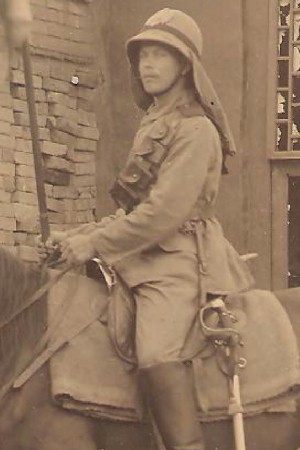
Reiter
of the East Asian Cavalry Regiment
This photograph taken in China, shows Reiter Emil Eduard Sawatzki of the
East Asian Cavalry Regt ("Ostasiatische
Reiter Regiment").
He wears the
East Asian 1900 Khaki Uniform,
consisting of a khaki tunic
with a stand and fall collar, concealed buttons to fasten the front
and two
breast and two hip pockets, all with concealed fastenings. His shoulder straps are
plain red for cavalry. This is curious as the February 1901 uniform
regulations for the khaki uniform stated the shoulder straps for the
cavalry were to be khaki piped in red. Full red shoulder straps such
as these were authorised for the field grey uniform only. He wears
matching khaki trousers tucked into high brown leather riding boots. He wears the 1900
Bortfeldt khaki tropical helmet with imperial eagle in yellow metal
on the front and a red cavalry hatband. A large imperial cockade
would be on the right hand side. Note the khaki neck shade. His equipment is the
grey leather bandolier for mounted troops with ammunition pouches
down the front and a grey leather belt. He is armed an East Asian
other ranks cavalry sword and lance. The lance has the pennant in
imperial colours. His carbine would usually be carried in a saddle
bucket on the other side.
Photo
©
Peter Klein |
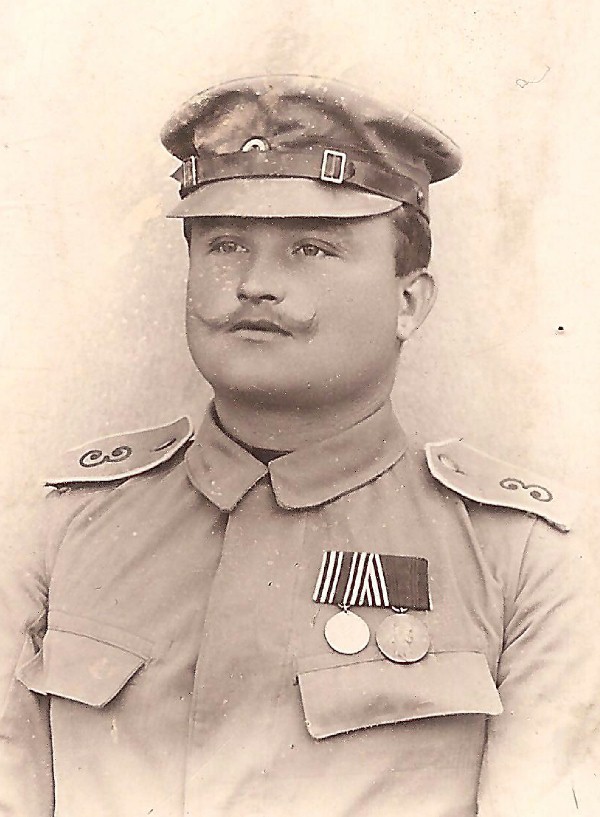
Musketier
of the 3rd East Asian Infantry Regiment
This is a posed studio photograph taken in China. It
shows a private ("Musketier") of the 3rd
East Asian Infantry Regt ("3.
Ostasiatische Infanterie Regiment").
He wears the
East Asian 1900 Khaki Uniform,
consisting of a khaki tunic
with a stand and fall collar, concealed buttons to fasten the front
and two
breast and two hip pockets, all with concealed fastenings. His shoulder straps are
khaki with white piping and a
red stylised regimental number 3 can be seen. He wears two medals on
his left breast, the China Campaign Medal with its striped
ribbon for service during the Boxer Rebellion 1900-01 and the Prussian Wilhelm I Centenary
Medal, awarded to all members of the Prussian army in 1897. It
hangs on a yellow ribbon which appears darker in this photograph
due to the orthochromatic film used at the time. He wears the Khaki field
cap first introduced in the late Summer of 1900 to replace the straw hat,
and worn with only the imperial cockade, as seen here, from February
1901.
Photo
©
Karsten Herzogenrath |
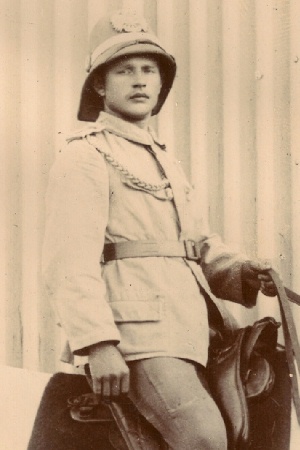
Mounted NCO
of an East Asian Infantry Regiment
He wears the
East Asian 1900 Khaki Uniform, consisting of a khaki tunic with a
stand and fall collar, concealed buttons to fasten the front and two
breast and two hip pockets, all with concealed fastenings. NCO lace can
be seen on the lower edge of the collar and he wears a marksmanship
lanyard from his shoulder strap. He wears the 1900 Bortfeldt khaki
tropical helmet with imperial eagle in yellow metal on the front and a
white infantry hatband. A large imperial cockade can be seen on the
right hand side.
Photo ©
Joe Robinson
|
|

NCOs of the 5th East Asian Infantry
Regiment, Tientsin May 1901
They wear the 1900 Summer uniform with Bortfeldt tropical helmets
and white hatbands for the infantry. These men all have NCO collar lace
and the single chevron on the left arm. The two in the centre are senior
NCOs as shown by them being armed with swords rather than the S98
bayonets carried by the rest of the group.
Photo ©
Jérôme Discours at Military Photos

East Asian Infantry on the march, Peking
1902
These men wear the East Asian 1900 Khaki Uniform, consisting of a
khaki tunic with a stand and fall collar, concealed buttons to fasten
the front and two breast and two hip pockets, all with concealed
fastenings. NCO lace can be seen on the lower edge of the collar of the
three in the foreground. They wear the 1900 Bortfeldt khaki tropical
helmet with imperial eagle in yellow metal on the front and a white
infantry hatband. They are armed with Gew98 rifles. Curiously, they
still have their old ammunition pouches before the new East Asian
equipment was issued.
Photo by CH Graves from the
American Library of Congress
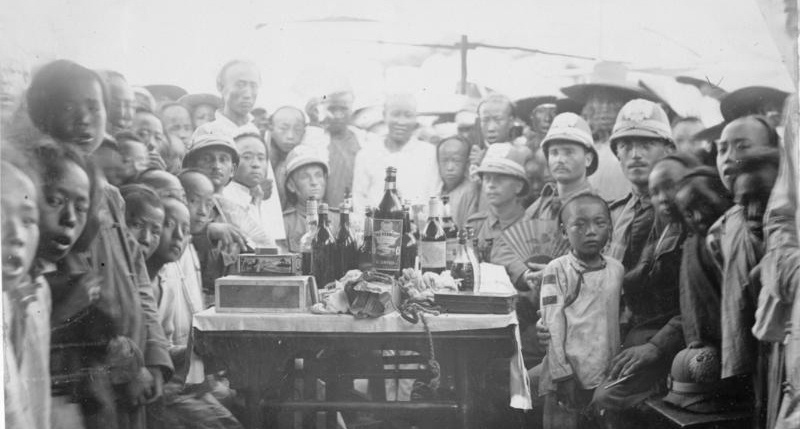
Soldiers of the East Asian Infantry with
Chinese Children
They wear the noticeably smaller 1904 Tropical Helmets. These were
field grey with white hatbands for infantry and yellow metal Imperial
eagles. The large imperial cockade on the right hand side of the helmet
can be clearly seen on the helmet in the bottom right of the photo.
Photo from Bundesarchiv /
Wikimedia

Group of International Soldiers and
Sailors in China
On the far left of the photo is a German NCO wearing the 1904
uniform with the smaller tropical helmet with a white infantry hatband.
From the collar and cuff lace, we see he is an NCO. The sword shows his
rank as a either Vize-Feldwebel or Feldwebel.
Photo ©
Jérôme Discours at Military Photos
Main Sources
"Uniformierung und
Austrüstung der Ostasiatischen Truppen des Deutschen Reiches 1900-1909" by Jürgen Kraus in
Zeitschrift für Heereskunde Nos 382 and
389 (unsure of last edition number)
"Tropenhelme der kaiserliche Marine, der
Ostasiatischen Truppen und der Schutzruppen"
by Ulrich Schiers, published by the
Deutsche Gesellschaft für Heereskunde
"The German Colonial Troops 1889-1918" by
Jürgen
Kraus and Thomas Müller
"Die deutsche Armee"- illustrated plates by Moritz Ruhl
"Deutsche Expeditionstruppen und
Schutztruppen"- illustrated plates by Edgar Graf von Matuschka
|



